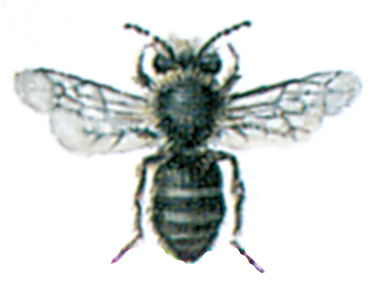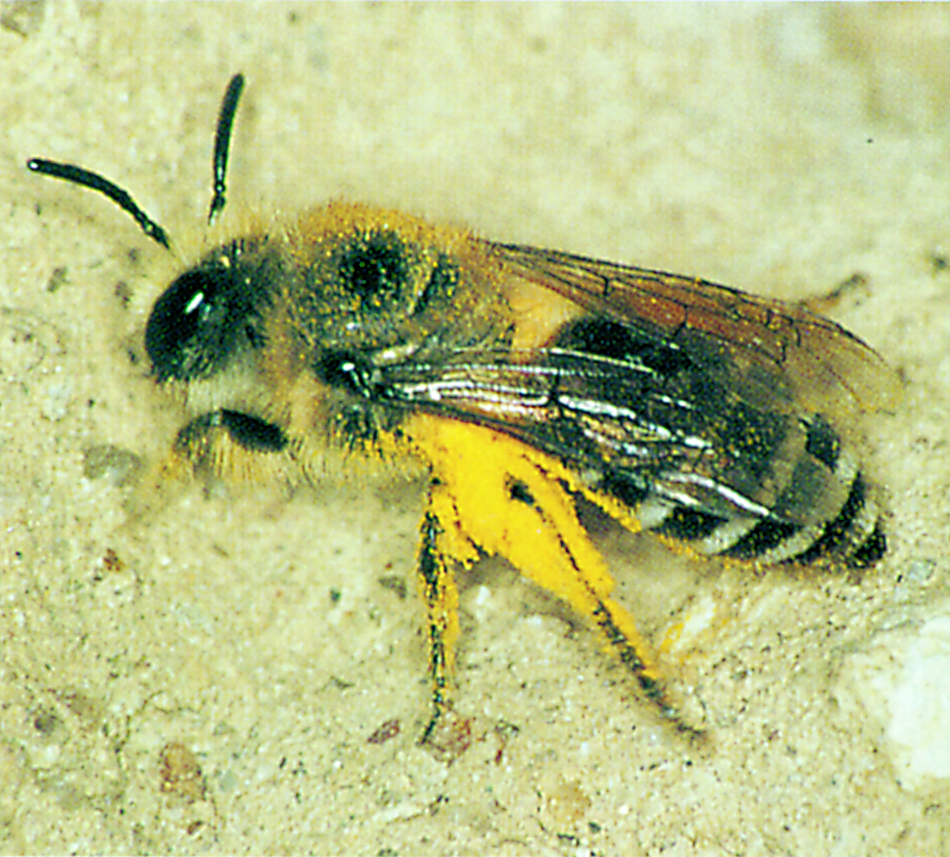(Latin: Colletes daviesanus)

These are solitary bees (p. 180) which do not form true colonies although several may live close together. Like other bees they have a sting, but are not very aggressive. In the wild they live in chalk or clay, but they may also live in mortar if it is not too hard.
These bees dig cylindrical, horizontal tunnels in the mortar, but do not enter cavity walls. They nearly always choose a sunny aspect, and on the whole they are most active when the sun is shining. The diameter of the tunnels is about the same as a pencil and they are lined with a very fine, transparent material which is secreted by the bee’s salivary glands. Each individual cell is 1 cm long and it is filled with a mixture of pollen and nectar. When it has been completed the bee lays an egg in it, seals it with a lid and starts on the next cell in the series. Normally there are
2-8 cells in each tunnel. The larvae which hatch from the eggs feed on the stored food, overwinter in the cell, pupate in the following spring and emerge as adult bees, usually in early July.
In normal circumstances the damage done by these bees is fairly restricted, but it can be annoying when plaster is being gnawed out the whole time, and in a serious attack when much mortar is being removed it may be necessary to take countermeasures.
Outside the period when the bees are flying (mid-June to mid-August) this can be done by simply scraping out the loose mortar together with the bee cells and larvae. If this is carefully replaced with a strong mortar containing cement it will not matter if some of the cells are still in place as any bees that emerge later will not be able to reach the surface.

On the other hand, if repair work has to be done during the period when the bees are on the wing they will need to be dealt with first otherwise they will be able to dig new holes before the mortar has hardened. Dusting the affected areas of wall with an insecticidal powder will usually solve the problem.
It should be remembered that even though the bees living in the mortar have been killed off there will always be a risk of a new attack so long as there are still areas of wall with loose mortar.
Now and again woodpeckers find out that there are fat, juicy bee larvae in the wall. Once they have learned the trick they will arrive and hack great craters in the mortar in order to get at the grubs. If one cannot tolerate this form of biological control it will be necessary to scrape out the larvae and make good the mortar.
Sparrows and tits often climb around walls searching for insects and spiders which they pull out of holes and crevices. Normally they do no damage to the wall, but sparrows and pigeons may peck lime out of the mortar and in some cases damage the bricks.
The larvae of dermestid beetles frequently gnaw their way into a variety of materials when they are about to pupate. It is rare for them to bore into plaster but they occasionally do so.
Glass wool used for insulation might not appear to be a very suitable material for nests but in spite of this, mice and rats will gnaw tunnels through it and construct their nests in it, thus reducing its effectiveness as an insulator.
Bumble bees may also establish them- selves in insulating material, but the damage done will be local and not very serious.
When tufts of insulating material appear under the eaves it will normally be due to sparrows or starlings that have pulled it out to make a place for their nests.




